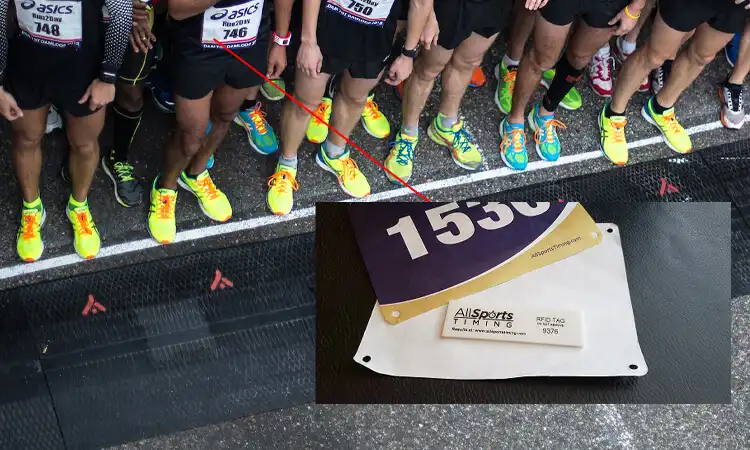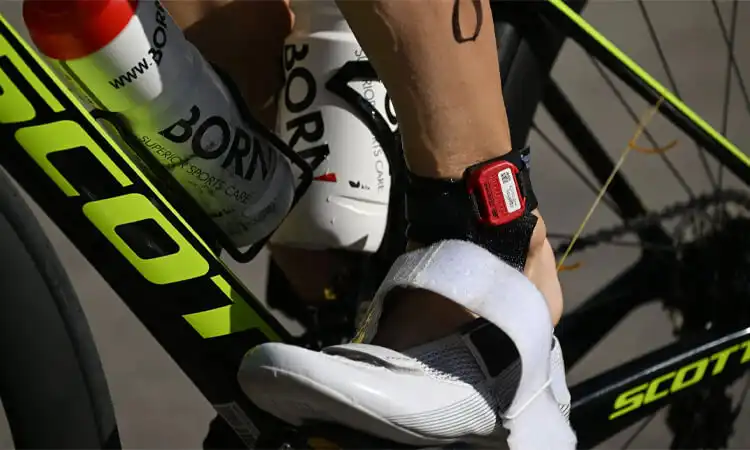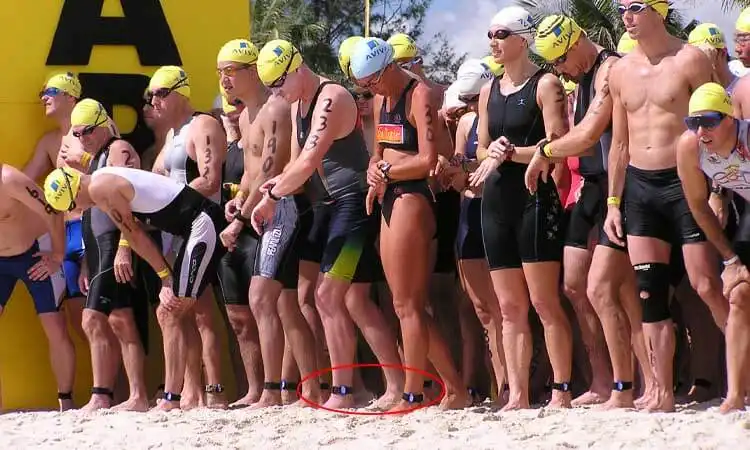RFID technology, including Timing Chips for Cycling, has become a popular solution for Race Timing Systems, particularly in foot races. The availability of cost-effective RFID inlays has made it an affordable option for race-timers. As technology has become more efficient, sensitive, and affordable, other types of races, such as cycling and go-kart races, have also started using RFID. The use of RFID Timing Chips in cycling races has become increasingly popular, providing accurate and reliable timing of participants in real time.
Types of Competitions Using RFID Timing Chip
There are several types of competitions that use RFID timing to accurately track and record performance. Here are a few examples:
RFID Timing Chip for Running
Marathon races are popular events that take place year-round across the world. In 2018, over 6 million people participated in registered road races in the US alone, making up approximately 1.6% of the population. Despite the rising cost per participant, the popularity of running races continues to grow.

Organizer: Road races are typically organized by cities, towns, organizations, or non-profit companies and held on roads or tracks.
These events attract a diverse range of participants, from casual runners to professional athletes.
RFID technology is highly utilized in foot races to provide accurate and efficient timing of participants. However, there are also several challenges involved in timing foot races, including:
- Managing dehydration and maintaining proper hydration levels in athletes.
- Ensuring accurate timing and finishing order by spacing out runners at the start and finish to avoid congestion.
- Optimizing RFID tag placement on runners enables the most reliable tracking of race times and positions.
Solutions: While several challenges are involved in using RFID technology for timing foot races, these can be overcome by investing time in testing and taking advantage of specialized RFID tags and strategic reader placement. By doing so, race timers can ensure accurate and efficient timing for all participants, providing a better experience for the racers and the organizers.
RFID tags commonly used in foot races include inlays and inlays with foam backing.
Some of the most well-known foot races that use RFID technology include:
- The Boston Marathon has been using RFID tags since 1999,
- The AJC Peachtree Road Race uses RFID chips attached to the runner’s bib,
- The New York City Marathon uses RFID tags attached to the runner’s shoe.
RFID tags are attached at various points on race participants to track timing and performance accurately. Common tagging methods include bib tags, dual bib tags, shoe tags, and hip packs.
- Bib tags attach RFID chips to the bib number, which racers wear on their chest.
- Dual bib tags use two tags per bib for redundancy to prevent missed reads.
- Shoe tags adhere RFID tags to racers’ shoes, typically on laces or soles. These precisely monitor a racer’s progress and prevent tag loss during the run.
- Hip packs secure RFID belts or straps around a racer’s waist or hips. They offer a stable, readable tag solution without interfering with mobility.
RFID Timing Chip for Cycling
RFID technology has become a popular and reliable solution for timing various types of bicycle races, including road cycling, off-road cycling, mountain biking, and BMX. Many races worldwide have adopted RFID chip timing, including some of the most well-known races, such as the Tour de France and La Ruta De Los Conquistadores.

Organizer: The RFID tag and placement choice depends on the specific race and participant’s needs.
RFID timing of bike races introduces additional complexities beyond those of foot races. Challenges include:
- Obstructed reads from the congested start/finish areas,
- Optimizing tag placement,
- Mitigating interference from bike metal components and environmental obstacles.
Solutions: Race timers may use specialized tags or adjust the start/finish line setup to improve read rates and mitigate these challenges.
In bicycle races, Radio Frequency Identification timing chips are used to ensure the accurate timing of participants. These chips can be applied to various bike parts, including the bib, bike frame, helmet, ankle, and other points. RFID tags used in bike races include waterproof hard tags, metal mount tags, RFID inlays, and foam-backed inlays.
Race coordinators invest time and effort to test each event’s best RFID timing chips and attachments. The optimal solution ensures that the chips adhere securely without hindering mobility or causing discomfort to the rider.
Bib tags attach RFID chips to race bib numbers worn on the chest, while bike tags mount tags directly to the bike frame. Helmet tags attach tags to the helmet, and ankle tags use straps or bands around the ankle. Metal mounts and foam-backed tags are more durable and less likely to detach, making them useful on bikes with large metal components. Waterproof and ruggedized tags can withstand exposure and endure the forces of riding.
RFID Timing Chip for Motor Vehicle Races
RFID technology has become an increasingly popular and reliable solution for timing various types of motor vehicle races, including motocross, dirt bikes, karts, snowmobiles, and ATVs. While some races, such as NASCAR, are too fast for UHF RFID alone, most motor vehicle races can be timed using RFID chips up to 60 mph.

In addition to UHF RFID, other technologies such as Active RFID, LF RFID, GPS, and Photo Finish equipment may be combined to provide additional features or data. The RFID tags used in motor vehicle races include metal-mount hard tags and foam-backed inlays attached to various vehicle parts, such as the helmet, grill, and visor.
Organizer: Motor vehicle racing events are organized by clubs, leagues, hobby groups, and touring series for enthusiasts and professionals. For amateurs, races occur at road courses, tracks, stadiums, and go-kart facilities. Professional racing consists of country-wide tours with stops at stadiums and dedicated tracks. Motorsport universities also offer programs for aspiring drivers to develop skills.
However, timing motor vehicle races with RFID technology presents unique challenges. Vehicle metal, high-speed crossing zones, and inclement weather can all hinder RFID reads.
- Metal components inherently reduce read range due to EM interference and shielding.
- When multiple vehicles pass concurrently through a read zone, RFID has fractions of a second to detect tags on each, challenging accurate timing.
- Environmental factors like mud, water, snow, and dust add another layer of complexity with multipath scattering and absorption. These effects are amplified at high speeds, especially.
Solutions: Thorough testing is key to addressing the challenges of high-speed reading, RF interference, and environmental factors. When working with two types of technology, such as passive UHF RFID and Active RFID, race timers must clearly understand each technology’s weaknesses, integration points, and keys to operation before testing.
RFID Timing Chip for Race Combinations
Combination races making RFID technology a popular solution for race timers, such as triathlons, require accurate and reliable timing of multiple events. However, it’s crucial to consider and address all the environmental factors to select an RFID tag that can withstand the entire race.

If you’re participating in a triathlon, you’ll want to choose an RFID tag that can withstand the rigors of swimming, biking, and running. A water-resistant, hard RFID tag is usually the best option, especially for the swimming portion of the race. This will ensure that the tag stays securely attached to your gear and provides accurate timing data throughout the entire race.
In order to ensure accurate and efficient timing of participants in triathlons and other combination races, race timers must invest time and effort into the testing process to select the appropriate RFID tag and attachment method for each specific race. Popular triathlons that use RFID technology include Outlaw Half Nottingham and Escape from Alcatraz.
- Scope
Cycling events typically have a start, multiple split points (or laps), and a finish. The timing system can record lap times as riders pass through the same checkpoint, and rankings can be based on both lap times and overall times. It’s worth noting that cyclists can reach up to 60km/hr as they cross the finish line, making for an exciting and challenging race.
- Method
Regarding timing a cycling event, side antennas are typically the most effective method, as they can accurately track riders as they pass through the timing point. However, mats can also be used for larger events, particularly at the start line. This can help ensure reliable and precise timing for all participants, regardless of the size of the event.
How to Use Latex Tubes to Install Bicycle Timing Chips
If you want to use latex tubes to install a timing chip on your bicycle, follow these steps:
- Step 1: Prepare the Timing Chip and Latex Tube
Make sure you have the timing chip and a latex tube that snugly fits around your bike’s fork. Cut the latex tube to the appropriate length, leaving about 1 inch of space on each side of the chip.
- Step 2: Protect Your Bike’s Frame and Fork
To avoid scratching your bike’s frame or fork, place a layer of electrical tape behind the chip and on the part of the fork where the chip will be attached. You can also use a bit of old bar tape beneath the chip.
- Step 3: Slide the Latex Tube onto the Fork
Choose which side of the fork you want to attach the timing chip to (most people use the right side). Stretch the latex tube and slide it up the fork until it’s in the desired position.
- Step 4: Insert the Timing Chip into the Latex Tube
Stretch the latex tube and insert the timing chip from the top, sliding it down until it’s snugly in place. You can insert the chip from the bottom, but it may be easier to slide it down from the wider top part of the fork.
- Step 5: Double-check the Positioning
Ensure the timing chip is in the desired position and that there is enough space on each side of the chip to prevent it from moving during the race.
Installing and Using RFID Timing Chips Tips
Installing and using RFID timing chips may seem intimidating, but it’s a straightforward process. Here are some tips to help you get started:
- Choose the right RFID timing chip for your race. Selecting the right timing chip is crucial. Factors such as the type of race (cycling, motocross, marathon), the number of participants, and the course layout should be considered before making a decision.
- Follow proper installation procedures. Each timing chip may have slightly different instructions, so read and follow them carefully. Typically, the chip is attached to the bike, motorcycle, or runner with a strap or adhesive.
- Test the timing chip before the race. Before the race starts, test the timing chip to ensure it’s working correctly. Most RFID timing systems have software that allows you to check the chip’s connectivity and accuracy.
- Place timing mats at strategic locations. Timing mats are usually placed at the start and finish lines and checkpoints along the course. Make sure they’re positioned in areas where they can capture the timing chip’s signal.
- Train staff on RFID technology. Make sure your staff is trained on how to use RFID timing technology. This will ensure that they can troubleshoot any issues during the race.
- Analyze the results after the race. After the race, analyze the timing data to identify areas for improvement. This will help you fine-tune your timing system for future races.
The use of RFID timing chips in cycling, motocross, and marathon races has changed the game for both organizers and participants. RFID timing chips are a must-have for any race with their precise and reliable results, streamlined registration process, and enhanced participant experience.
Related Articles: Chip Timing vs Gun Timing: What’s the Difference?
About RFID Timing Chip for Cycling Problem
-
What is an RFID timing chip, and how does it work?
An RFID timing chip is a small electronic device attached to a bike or rider during a race. It emits a radio signal picked up by timing mats placed along the course, which record the chip’s identity and the time it passes over the mat.
-
What are the benefits of using RFID timing chips for cycling races?
RFID timing chips provide accurate and reliable results, streamline registration and results tracking, and enhance the participant experience.
-
What are the best practices for attaching RFID timing chips to bikes or riders?
Most RFID timing chips come with a strap or adhesive that should be attached to the bike or rider according to the manufacturer’s instructions. You should also test the chip before the race to ensure it’s working correctly.
-
What are the most common issues with RFID timing chips, and how can you troubleshoot them?
Common issues include connectivity problems and damage to the chip or timing mat. Troubleshooting may involve checking the connectivity of the chip, replacing the chip or mat, or consulting with technical support.
-
How do timing mats work, and where should they be placed along the course?
Timing mats are placed at the start, finish, and checkpoints along the course. They record the radio signal emitted by the RFID chip, which calculates the racer’s time.
-
How can RFID timing chips improve the accuracy of race results and reduce disputes?
RFID timing chips provide precise and reliable results less prone to human error or tampering, reducing the risk of disputes over race results.
-
Can RFID timing chips be reused, or must they be replaced after each race?
RFID timing chips can usually be reused for multiple races, but this depends on the specific chip and manufacturer. Make sure to follow the manufacturer’s guidelines for proper use and storage.
-
What are the costs associated with using RFID timing chips for cycling races?
The costs of RFID timing chips vary depending on the type of chip, number of participants, and other factors. However, RFID timing chips are generally considered cost-effective compared to other timing methods.
-
How can RFID timing chips enhance the overall experience for cyclists and race organizers alike?
RFID timing chips provide accurate, efficient, and reliable results that improve the overall experience of racers and organizers. This can lead to increased participation, improved performance, and a more positive reputation for the race.








